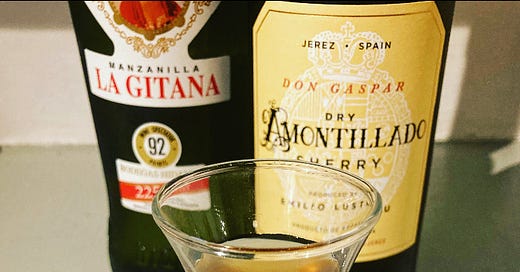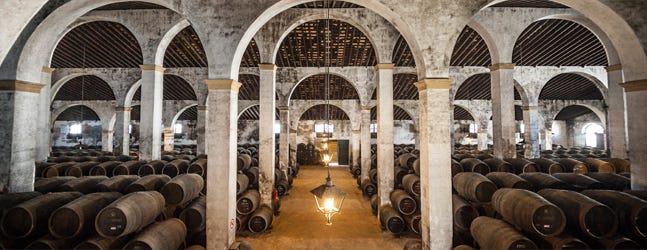The Cabinet: Sherry
"The Amontillado!" ejaculated my friend, not yet recovered from his astonishment. "True," I replied; "the Amontillado."
~ SHERRY ~
Fortified wine from Andalusia, Spain. From 15-17% ABV (Fino) to 17-22%ABV (Oloroso, £5-£50+ for 700ml
Friends with: gin, brandy, rum and agave spirits. All sorts of fruits (orange, raspberries, pears, figs, bananas, and most especially, peach and apricot…). Cucumber. Elderflower. Lavender. Thyme. Olives. Chartreuse. Cynar. Maraschino. Tonic.
For some years now - decades even! - there have been rumours, whispers, murmurings of a sherry revival. Sherry, someone just back from Cadiz will exclaim, is actually delicious. Just the thing for a heatwave too. All the hip Spanish kids are drinking manzanilla - and get this: they’re drinking it on ice. Articles are duly produced saying “Not your granny’s tipple!” Pairing notes are drawn up: fino and oysters; amontillado and Iberico ham (sherry is nothing if not food-friendly). Wine pros do their best to whip up enthusiasm. And sherry remains as about as hip as, ooh, a Hard-Fi CD.
This is, as far as I’m concerned, excellent. Why? It would be a disaster if for the impecunious gourmand were sherry suddenly to become fashionable in the manner of, say, natural wine or mezcal. Then there would no longer be bottles of amontillado on sale for, like, £6 in Co-Op or, as I seem to remember, $4(!) in the American supermarket, Trader Joe’s. For despite all of these “sherry, delicious, honestly!” articles, sherry sales have been falling since 1979 and apparently halved in the UK between 2005 and 2015. (Indeed, it was only during the pandemic that they ticked up again according to Waitrose; but then again, pretty much all alcohol sales ticked up during the pandemic). This is not such great news for your bodega owner; but it is good news for you and me. We are able to pick up some of the finest wines known to humanity - many of them containing atoms of 50-year-old wines! - for the price of two or three flat whites. The amontillado pictured above, incidentally, was £11.99. It’s made for Waitrose by Lustau, the most awarded winery in the whole of the Jerez-Xérés-Sherry DOP, and aged in a Borgesian labyrinth:
Do you find such value in Champagne? You do not.
Right, so naturally sherry has a rich and fascinating history and I’m not going to bore you with it here. Of note, however, is the solera ageing system, whereby barrels of all ages of sherry are fractionally blended over time in order to ensure consistency of product - so, a sherry with an average age of five years might contain sherries of 20 years old (and 19, and 18, and 17, etc) which goes some way to explaining the drink’s multi-layered complexity. There are many different styles, too - and you will find a useful and not too onerous outline of the major categories here, in rough order of dryness: Fino, Manzanilla, Amontillado, Oloroso, Palo Cortado, Pedro Ximenez and Moscatel.
There’s another category too: cream sherries (e.g. Harvey’s Bristol Cream), typically a blend of Oloroso and Pedro Ximenez, varying in sweetness. These are your classic trifle sherries, the sort your nan might have sipped. If you come across a vintage recipe that says “sherry” it’s probably going to be cream sherry. However, in recent years, the drier styles have come more into vogue, both for their food-friendliness, and among bartenders for their versatility. Dry sherry makes a great base for low-alcohol, apéritif-type cocktails, as it’s typically less than half of the ABV of spirits, but still carries tons of flavour. And yet, dry and medium sherries will also work rather nicely in the “vermouth” role, lending depth, aroma and length to your base spirit. Hell, you can even use the sweeter Pedro-Ximenez as a liqueur.
Neverthless, to keep things simple, I am going to home in on the two styles that I find to be the most versatile and cocktail appropriate: Fino and Amontillado. The recipes below will tend to call for one or the other or either.
Fino is the driest, palest style of sherry, crisp, lightly acidic, liable to have you salivating almost immediately. I like to think of it in the same loose cocktail family as gin and French vermouth; in fact, fino is the “secret ingredient” in many prized Martini recipes, and a gin Martini made with fino = a TUXEDO. Tio Pepe Fino is widely available for about a tenner and is probably the wine I buy most often. Fino Perdido is heavenly too and has a cool bottle. Manzanilla is similar to fino, but more delicate and floral. The lovely La Gitana is widely available and wonderful as an aperitif, especially with seafood - but it can fade in cocktails. Whereas fino will stand up to anything you throw at it.
Amontillado begins as fino but is then subject to a secondary ageing process that gives it a distinctive hazelnutty-leathery-woody deliciousness. Oloroso (the darkest, strongest type of sherry) subs in for this pretty well, but I prefer that distinct nuttiness of amontillado. (So, unfortunately, does the wine merchant Fortunato in Edgar Allen Poe’s revenge tale, The Cask of Amontillado, who meets a grizzly end as a result). The driest amontillados are a good sub for brandy, bourbon and dark rum, but there are also sweeter medium styles which work in place of Italian vermouth. In fact, while living in the US, I quite often used the aforementioned Trader Joe amontillado in a rough-and-ready Gin & It riff (a GIN & SPANISH?), c.50ml gin, 25ml amontillado, dash of Angostura bitters, black olive garnish. Bottle-wise, I particularly like La Gitana’s Amontillado Napoleon, rather dry, and I’ve never gone far wrong with anything from Lustau or Gonzalez-Byass. But as I mentioned - the supermarket own brands are usually extremely serviceable.
Cocktails below the line!
CABINET POSTS YOU MAY HAVE MISSED:
🌿Green Chartreuse
🍒 Maraschino
🍑 Apricot Brandy
🍫 Crème de Cacao
🌷Cynar
🏝️Falernum
🌵Mezcal
Keep reading with a 7-day free trial
Subscribe to The Spirits to keep reading this post and get 7 days of free access to the full post archives.





